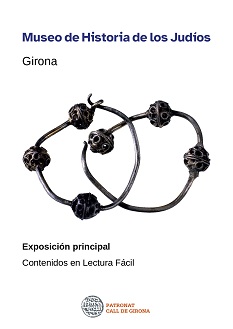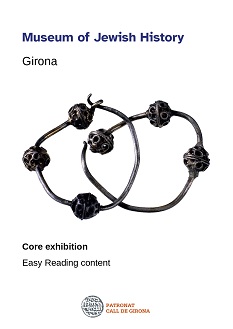
Museum accessibility
 |
 |
 |
 |
| Reduced mobility | Visual impairment | Hearing disability | Intellectual disability |
The Patronat Call de Girona wants to guarantee the right of all people to participate in culture, through universal accessibility and social inclusion.
The Museum of Jewish History is a museum of everyone and for everyone.
How do you access the Museum?
The Museum of Jewish History is located in 8, Forša street.
It can be accessed on foot.
The street is paved, with irregular cobblestones and a slope with an inclination of between 8% and 12%.
The Jewish quarter is characterized by its narrow streets, with steep slopes and stairs.
If you arrive by private vehicle, there is 1 free space reserved for people with reduced mobility in Plaša de Sant Josep, 290 meters from the Museum.
If you arrive by public transport, the nearest stop is L12 Cort Reial (accessible, on the sidewalk), 210 meters from the Museum.
If you arrive by taxi, you can get off at Plaša de la Catedral, 50 meters from the Museum, or at Plaša de l'Oli, 150 m away of the Museum.
Entry is free for the holder of the disability card. The companion will also have free entry when this is indicated on the disability card.
 Reduced mobility
Reduced mobility
Main entrance
It is accessible with difficulty: there is a ramp with three steps of less than 2 cm to reach the reception.
Temporary exhibitions rooms
They are located on the ground floor, in front of the Museum reception.
They are accessible through a ramp.
Core exhibition
It is located on the first and second floor of the Museum.
It is accessible with difficulty: there are stairs of more than 5 cm to access the first floor.
You can reach the elevator after overcoming a step of more than 5 cm.
To use the elevator, you must ask at reception. Museum staff will accompany you to the elevator and show you the route to follow.
This service is available from Monday to Saturday, from 10 am to 2 pm.
If you want to visit the Museum in the afternoon, you must first call (+34) 972 216 761 to find out if staff will be available.
It is easy to move around the spaces of the Museum.
There is a step between 2 and 5 cm that can be overcome with a ramp.
The museum path is easy to follow.
If you go up to the first floor by elevator, ask reception how to follow the museum itinerary.
The vast majority of showcases and objects on display are at a height visible to people in wheelchairs.
Mikveh
It is the only space inaccessible to people in wheelchairs, as it is very narrow and accessed by stairs of more than 5 cm.
Since 2021 it can be visited virtually through an interactive:
(Open in a new window)
Information desk
It is not adapted, but the staff of the Museum is available to assist you at all times.
 Visual impairment
Visual impairment
The lighting inside the Museum is good.
The exhibition furniture does not hinder passage.
Most texts have good contrast.
The size of the texts in Catalan language is good.
The size of the texts in Spanish, English and French is a bit small.
On the first floor there is an audiovisual room with audio in Catalan.
The audio guide, without audio description, is in Catalan, Spanish, English, French and Hebrew.
 Hearing disability
Hearing disability
 |
Hearing induction loop at the reception desk |
The exhibition has explanatory texts in the rooms, in Catalan, Spanish, English and French.
The audiovisual on the first floor has the audio in Catalan, subtitles in Catalan, Spanish, English and French and interpretation in Catalan sign language.
You can check the audiovisuals with interpretation in Catalan sign language in our media library.
 Intellectual disability
Intellectual disability
The Museum has the contents of the main exhibition in Easy Reading. You can download the PDF here:
 |
 |
 |
 |
These contents have been created with the help of the Economic Promotion Area, Local Development, Tourism and Occupation, Tourism department, of the City council of Girona, within the territorial cooperation programme POCTEFA 2014-2020 (Programa INTERREG V-A Espa˝a-Francia-Andorra), created with European funds.
We specially recommend the Guide Girona Tourism for All and the Accessible tourism map.
© 2026 Patronat Call de Girona | Contact | Accessibility
